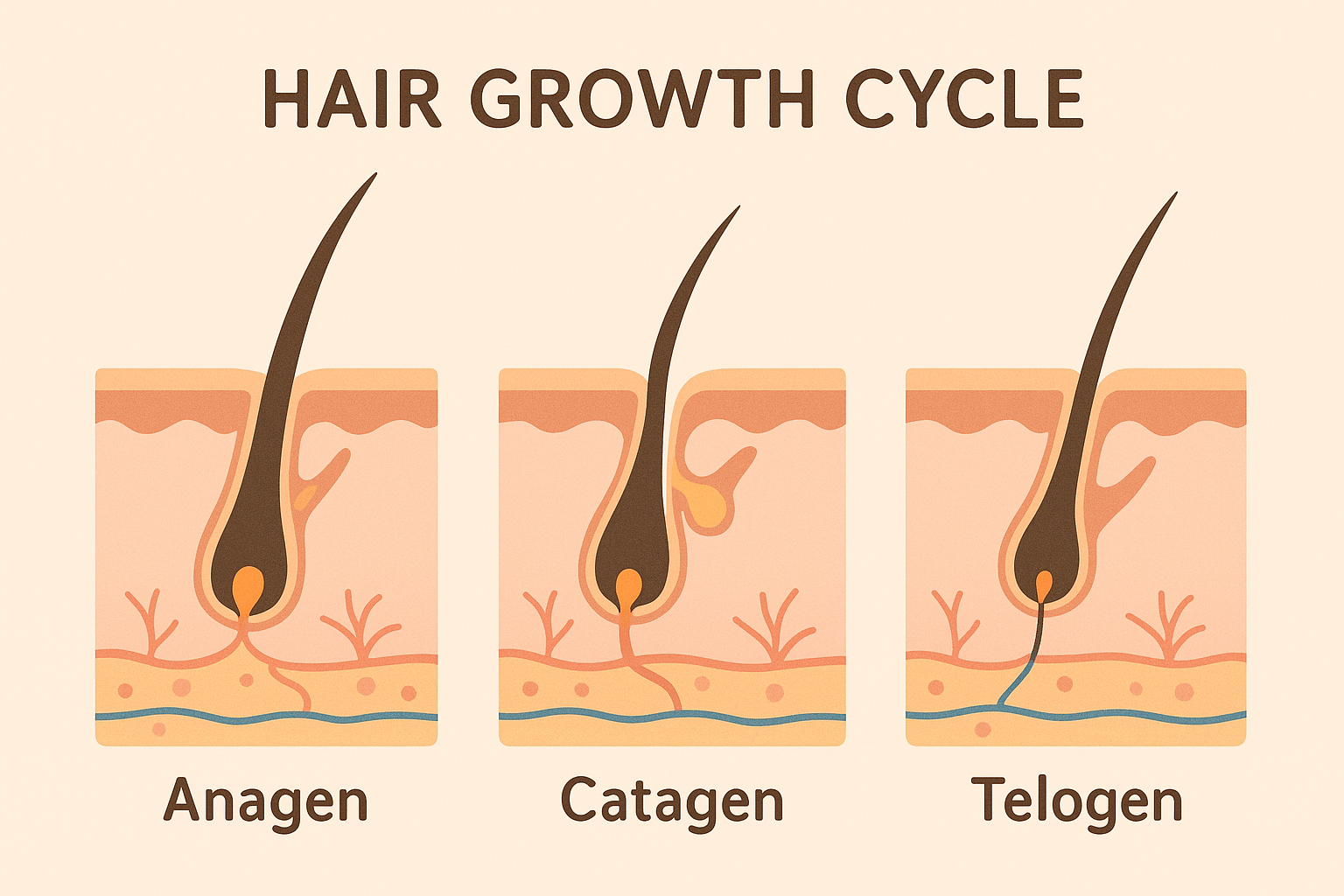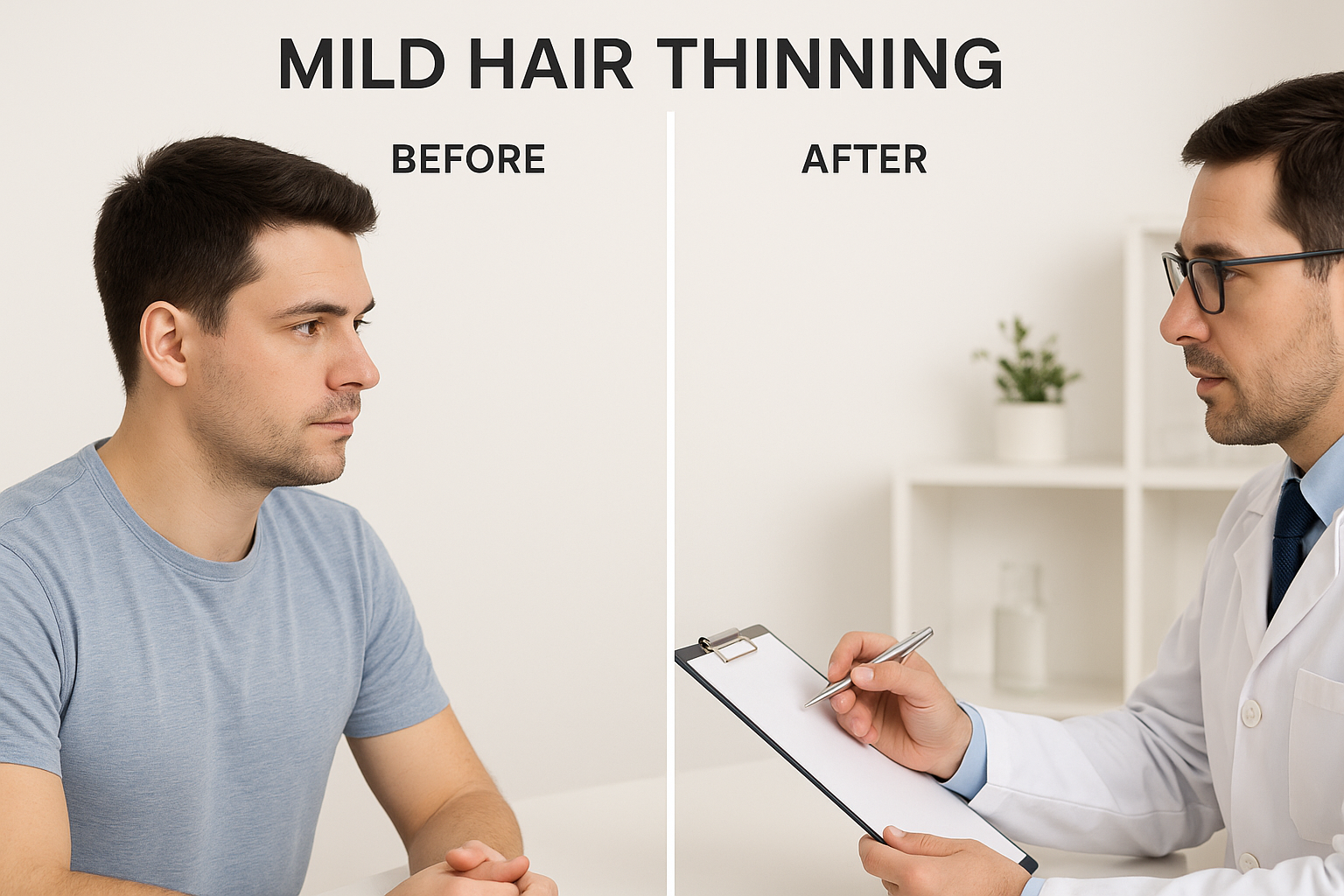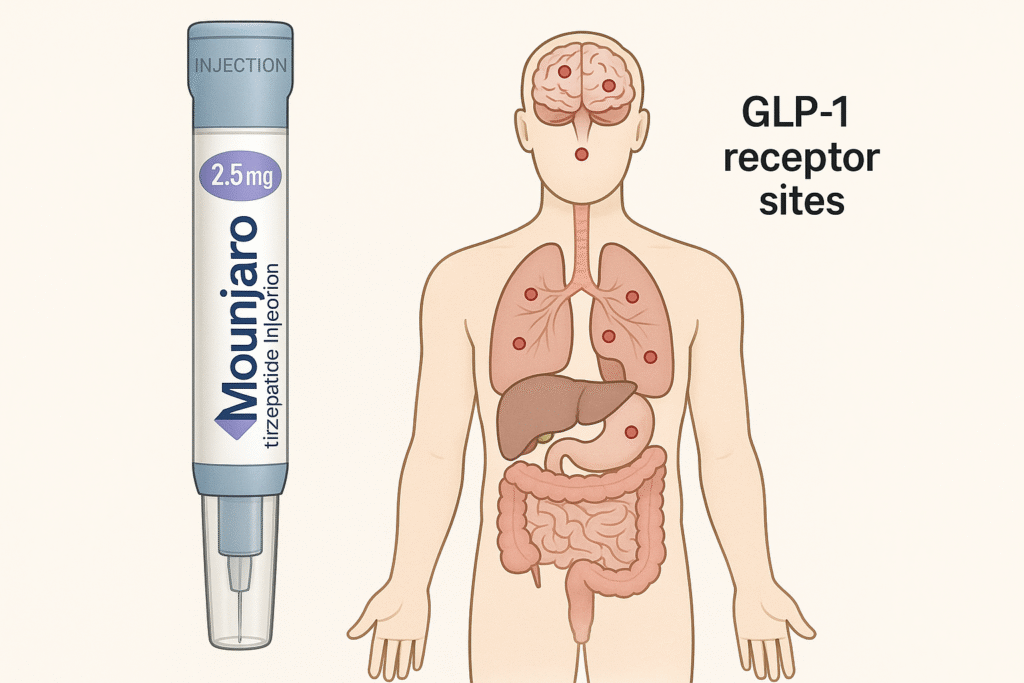Introduction
Mounjaro (tirzepatide) has emerged as a breakthrough medication for managing both diabetes and weight loss, offering new hope for millions of patients struggling with these interconnected health conditions. However, as with any powerful medication, questions about potential side effects naturally arise among patients and healthcare providers alike.
One concern that has gained attention among those taking Mounjaro is whether this medication might contribute to hair loss. If you’re considering or currently using Mounjaro, understanding the relationship between this weight loss medication and potential hair changes is crucial for making informed decisions about your treatment journey.
While hair loss isn’t listed among the most common Mounjaro side effects in clinical trials, some patients have reported experiencing hair thinning while on this medication. This raises important questions about the connection between rapid weight loss and hair health that deserve careful examination.
This comprehensive guide will help you understand how Mounjaro works and its approved uses for diabetes and weight management. We’ll explore the science behind hair growth and the various factors that can trigger hair loss, helping you distinguish between medication-related effects and other potential causes. You’ll learn about the specific types of hair loss that may occur with weight loss medications and review the available clinical evidence alongside real patient experiences.
Most importantly, we’ll provide practical strategies for managing and preventing hair loss while taking Mounjaro, along with clear guidance on when to consult your healthcare provider about any concerns.
Key Takeaways – TL/DR
- Hair loss is not a commonly reported side effect of Mounjaro in clinical trials
- Rapid weight loss from any cause (diet or medication) can trigger temporary hair thinning called telogen effluvium.
- Most hair loss related to weight loss medications is temporary and reversible
- Maintaining a balanced diet and consulting healthcare professionals can help minimize hair loss risk
- If you notice significant hair loss while taking Mounjaro, contact your doctor for evaluation
What is Mounjaro and How Does It Work?
Mounjaro (tirzepatide) represents a groundbreaking advancement in diabetes and weight loss treatment, offering patients a dual-action approach to managing these interconnected health conditions. Understanding how this medication works helps contextualize potential side effects, including concerns about hair loss that some patients may experience.
Mechanism of Action
Mounjaro works by targeting two key hormone receptors: GLP-1 (glucagon-like peptide-1) and GIP (glucose-dependent insulinotropic polypeptide) receptors [1]. This dual receptor activation enhances the body’s natural blood sugar regulation mechanisms by stimulating insulin release when glucose levels are elevated and suppressing glucagon production. Additionally, Mounjaro significantly affects appetite suppression by slowing gastric emptying and promoting satiety signals to the brain, which contributes to its effectiveness as a weight loss treatment.
Approved Medical Uses
The FDA approved Mounjaro in May 2022 for treating type 2 diabetes in adults [1]. Healthcare providers prescribe Mounjaro as a once-weekly injection to help patients achieve better glycemic control. In 2023, the FDA expanded approval for weight management in adults with obesity, marketed as Zepbound [2]. When starting Mounjaro, patients typically begin with a low dose that gradually increases to minimize side effects while maximizing therapeutic benefits for both diabetes management and weight loss treatment goals.

Understanding Hair Loss and Its Causes
Understanding the natural hair growth cycle and common causes of hair loss is essential for determining whether medication might be contributing to hair thinning. Hair follicles naturally cycle through distinct phases, and various factors can disrupt this normal process. This knowledge helps distinguish between normal hair shedding and potential medication-related effects on the scalp.
Normal Hair Growth Cycle
The hair growth cycle consists of three distinct phases that determine healthy hair growth throughout our lives. During the anagen phase, hair follicles actively produce new hair strands, with this growth stage typically lasting between 2-7 years depending on genetics. The catagen phase represents a brief transition period lasting 2-3 weeks, where hair follicles begin to shrink and prepare for rest. Finally, the telogen phase is a resting period lasting approximately 2-3 months, after which hair naturally sheds from the scalp to make room for new growth cycles.
Common Causes of Hair Loss
Several factors can disrupt normal hair growth patterns and trigger excessive hair shedding beyond typical daily loss. Genetics and hormonal changes are primary drivers of hair loss, particularly androgenetic alopecia affecting both men and women. Stress and illness can push hair follicles into the telogen phase prematurely, causing telogen effluvium, a temporary but noticeable increase in hair shedding across the scalp. Nutritional deficiencies, particularly iron, protein, and essential vitamin deficiencies, can also significantly compromise healthy hair growth by depriving hair follicles of vital nutrients needed for optimal function.

The Connection Between Mounjaro and Hair Loss
The relationship between Mounjaro and hair loss has emerged as a significant concern among patients, though understanding the direct connection requires careful examination of available evidence. Clinical trials of tirzepatide, including the landmark SURMOUNT-1 study, did not identify hair loss as a prominent adverse event in their comprehensive safety analyses [2]. However, this absence from primary trial data doesn’t necessarily rule out hair loss as a potential side effect, particularly given the relatively short duration of most clinical studies.
Post-marketing surveillance and patient reports have provided additional insights into whether individuals taking Mounjaro experience hair loss. While hair loss is not currently classified as a common side effect in official prescribing information, anecdotal reports from patients and healthcare providers suggest that some people do notice hair loss while on this medication [1]. The challenge lies in determining whether this represents a direct drug effect or is secondary to the rapid weight loss that Mounjaro facilitates.
The most plausible mechanism linking Mounjaro to hair loss involves the medication’s profound effects on weight reduction and metabolic changes. Rapid weight loss, regardless of the method, can trigger telogen effluvium, a form of temporary hair loss that occurs when hair follicles prematurely enter the resting phase. When patients lose significant weight quickly while taking Mounjaro, their bodies may experience nutritional stress and metabolic shifts that disrupt normal hair growth cycles. This type of temporary hair loss typically begins 2-4 months after the triggering event and often resolves once the body adapts to its new metabolic state.

Types of Hair Loss Associated with Weight Loss Medications
Weight loss drugs can trigger several distinct patterns of hair loss, with the condition called telogen effluvium being the most prevalent type experienced by patients. Understanding these different manifestations helps individuals recognize normal versus concerning hair changes during treatment and set appropriate expectations for recovery timelines.
Telogen Effluvium Explained
Telogen effluvium represents a stress-induced disruption of the normal hair growth cycle, commonly triggered by weight loss and rapid metabolic changes [3]. This condition occurs when hair follicles prematurely enter the resting phase, leading to increased shedding approximately two to four months after the initial stressor. Unlike localized hair loss patterns, telogen effluvium causes diffuse hair thinning across the entire scalp, making it particularly noticeable to patients. The delayed onset often surprises individuals, as the hair loss becomes apparent well after starting medication. This widespread thinning pattern distinguishes it from other forms of medication-related hair loss and typically affects 30-50% more hairs than normal daily shedding rates.
Temporary vs Permanent Hair Loss
Most medication-induced hair loss, particularly telogen effluvium, represents temporary hair loss that resolves once the triggering factor is addressed [4]. Hair regrowth typically begins three to six months after the stressor is removed or the body adapts to the medication. Signs of recovery include decreased daily shedding and emergence of new, shorter hairs along the hairline. Permanent hair loss from weight loss drugs remains extremely rare, usually occurring only in cases of severe nutritional deficiencies or underlying genetic predispositions.
Clinical Evidence and Patient Reports
Clinical trial data from the SURMOUNT-1 study examining tirzepatide for obesity treatment provides objective evidence regarding alopecia incidence among participants. In this landmark trial involving 2,539 adults, hair loss was reported as an adverse event in approximately 3-5% of patients receiving tirzepatide compared to 1-2% in placebo groups [2]. The frequency of alopecia appeared dose-dependent, with higher incidences observed at maximum therapeutic doses. These findings align with the broader pattern of other side effects commonly associated with significant weight loss medications, particularly during periods of rapid metabolic adaptation.
Comparative analysis with other weight loss medications and GLP-1 receptor agonists reveals similar alopecia rates across this drug class. The SURPASS clinical trial program demonstrated that tirzepatide’s hair loss profile remains consistent with semaglutide and liraglutide, suggesting a class effect rather than medication-specific phenomenon [1]. Patients experiencing significant weight loss of 15% or greater showed higher reporting rates of temporary hair thinning, regardless of the specific GLP-1 medication used.
Medical literature indicates that hair loss severity typically correlates with the velocity of weight reduction rather than medication dosage alone. Most documented cases represent telogen effluvium, a reversible condition that resolves within 3-6 months as patients adapt to their weight loss journey and metabolic changes stabilize.
Risk Factors for Hair Loss on Mounjaro
Certain patient characteristics and health circumstances may increase the likelihood of experiencing hair loss while taking Mounjaro. Understanding these risk factors can help healthcare providers and patients identify those who may need closer monitoring or additional nutritional support to maintain healthy hair during treatment.
Rapid Weight Loss Impact
Patients experiencing rapid weight loss on Mounjaro face increased hair loss risk due to metabolic stress on the body. When weight loss exceeds 1-2 pounds per week, the body may enter a state of metabolic shock, diverting energy away from non-essential functions like hair growth. This stress typically triggers telogen effluvium, where hair follicles prematurely enter the resting phase. Hair loss usually becomes noticeable 2-4 months after the onset of rapid weight loss, regardless of the method used to achieve it.
Nutritional Considerations
Patients with pre-existing conditions like kidney disease or those struggling to maintain a balanced diet face heightened risk. Mounjaro can reduce appetite significantly, making it challenging to meet protein requirements essential for healthy hair. Key nutrients including iron, zinc, biotin, and vitamins D and B12 become particularly important. Changes in nutrient absorption combined with reduced food intake can create deficiencies that prevent hair loss through proper nutritional support.
Managing and Preventing Hair Loss While Taking Mounjaro
While taking Mounjaro, patients can implement several evidence-based strategies to support hair growth and minimize the risk of hair loss. These proactive approaches focus on optimizing nutrition and adopting gentle hair care practices that promote maintaining healthy hair throughout treatment.
Nutritional Support for Hair Health
Adequate protein intake forms the foundation of hair health, as hair follicles require amino acids to stimulate hair regrowth effectively. Aim for lean proteins like fish, poultry, eggs, and legumes at each meal to meet daily requirements. Essential nutrients including iron and vitamin D play crucial roles in hair follicle function, so consider having levels tested if experiencing hair concerns. B-complex vitamins, particularly biotin, support cellular processes involved in hair production and may help maintain hair strength. Foods rich in these nutrients include leafy greens, nuts, seeds, and whole grains, which provide natural sources of vitamins that support hair growth without requiring additional supplementation.
Hair Care Best Practices
Gentle hair care techniques significantly impact hair health during Mounjaro treatment. Wash hair with lukewarm water using gentle shampoos two to three times weekly, and avoid excessive brushing when wet to prevent breakage. Always apply heat protectant products before using styling tools, and limit heat styling to twice weekly or less to reduce damage. Avoid tight hairstyles like ponytails, braids, or buns that create tension on hair follicles and may worsen hair loss. Instead, opt for loose styles that allow hair to move naturally. Consider silk or satin pillowcases to reduce friction during sleep, further supporting efforts to maintain healthy hair throughout your weight loss journey.

When to Contact Your Healthcare Provider
Recognizing when hair loss requires professional attention is crucial for maintaining both your health and peace of mind. While mild hair thinning may be a temporary side effect, certain warning signs indicate it’s time to contact your healthcare professional for evaluation and guidance.
You should schedule an appointment if you experience excessive shedding that continues for more than three months, notice that your hair stops growing entirely, or develop bald patches rather than general thinning. Additionally, seek medical attention if hair loss is accompanied by scalp irritation, redness, or pain, as these symptoms may indicate underlying conditions unrelated to your medication.
When discussing your concerns with your healthcare professional, be prepared to describe the timeline of your hair loss, its severity, and any other symptoms you’ve experienced. Your doctor can assess whether your current dosage needs adjustment or if alternative weight management strategies might be more suitable for your situation. They may also evaluate whether other factors could be contributing to your hair loss.
Don’t stop taking Mounjaro without medical supervision, as this decision requires careful consideration of your overall treatment goals. Your healthcare provider can help you weigh the benefits of continued therapy against the impact of hair loss, potentially recommending supportive treatments that may encourage hair regrowth while maintaining your weight management progress. Remember that the ability to produce hair often returns once any medication-related factors are addressed.
Conclusion
The relationship between Mounjaro and hair loss represents a manageable concern for many patients beginning this weight loss medication. While some individuals may experience hair thinning during their treatment journey, current evidence suggests that most cases of temporary hair loss are reversible and often related to rapid weight changes rather than direct medication effects.
Understanding the distinction between different types of hair loss is crucial for patients taking weight loss medications like Mounjaro. Telogen effluvium, the most common form of medication-related hair thinning, typically resolves within six to twelve months as hair follicles return to their normal growth cycle. This temporary nature should provide reassurance to those experiencing hair changes during treatment.
Maintaining optimal hair health while using Mounjaro involves adopting supportive practices such as following a nutrient-rich diet, managing stress levels, and using gentle hair care routines. However, the most important step for anyone concerned about hair loss is consulting with a healthcare professional who can provide personalized guidance based on individual circumstances and medical history.
By working closely with medical experts, patients can effectively balance their weight loss goals with overall health considerations, ensuring that any hair-related concerns are properly addressed and monitored throughout their treatment journey with confidence.
Frequently Asked Questions
Hair loss is not listed as a common side effect in Mounjaro’s clinical trials. However, some patients may experience hair thinning due to rapid weight loss, which can trigger a temporary condition called telogen effluvium.
If hair loss is related to rapid weight loss from Mounjaro rather than the medication itself, it’s typically temporary. Most people see hair regrowth within 3-6 months once their weight stabilizes and nutritional status improves.
Never stop taking Mounjaro without consulting your healthcare provider. They can evaluate whether the hair loss is related to the medication, rapid weight loss, or other factors, and help you weigh the benefits and risks of continuing treatment.
A balanced diet with adequate protein, iron, and vitamins is most important for hair health. While biotin and other supplements are popular, focus on meeting nutritional needs through food first and discuss any supplements with your healthcare provider.
References
- Rosenstock J, Wysham C, Frías JP, et al. Efficacy and safety of a novel dual GIP and GLP-1 receptor agonist tirzepatide in patients with type 2 diabetes (SURPASS-1): a double-blind, randomised, phase 3 trial. Lancet. 2021;398(10295):143-155. PMID: 34186022
- Jastreboff AM, Aronne LJ, Ahmad NN, et al. Tirzepatide Once Weekly for the Treatment of Obesity. N Engl J Med. 2022;387(3):205-216. PMID: 36239655
- Grover C, Khurana A. Telogen effluvium. Indian Dermatol Online J. 2013;4(4):313-318. PMID: 23974577
- Almohanna HM, Ahmed AA, Tsatalis JP, Tosti A. The Role of Vitamins and Minerals in Hair Loss: A Review. Dermatol Ther (Heidelb). 2019;9(1):51-70. PMID: 30547302











